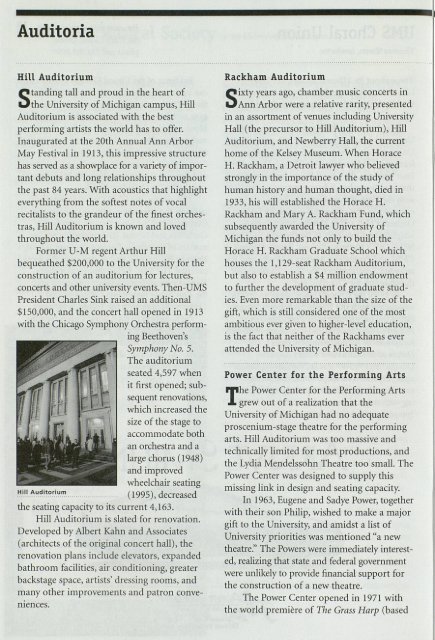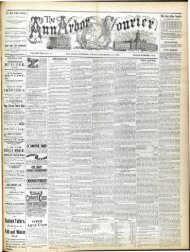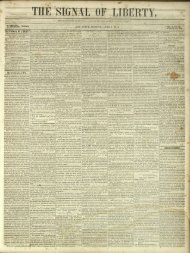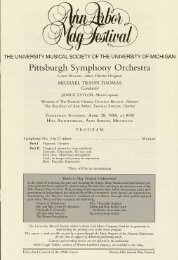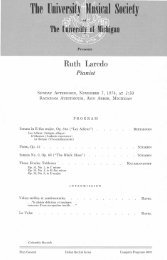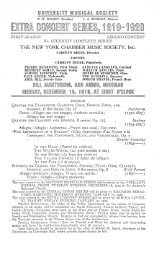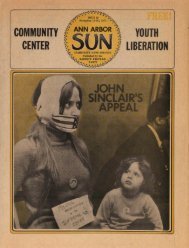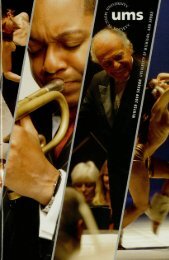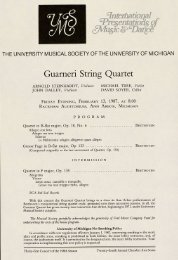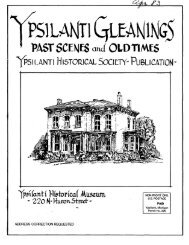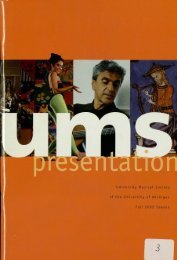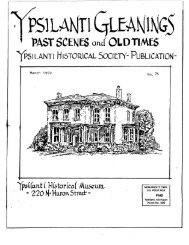University Musical Society - Ann Arbor District Library
University Musical Society - Ann Arbor District Library
University Musical Society - Ann Arbor District Library
Create successful ePaper yourself
Turn your PDF publications into a flip-book with our unique Google optimized e-Paper software.
Auditoria<br />
Hill Auditorium<br />
Standing tall and proud in the heart of<br />
the <strong>University</strong> of Michigan campus, Hill<br />
Auditorium is associated with the best<br />
performing artists the world has to offer.<br />
Inaugurated at the 20th <strong>Ann</strong>ual <strong>Ann</strong> <strong>Arbor</strong><br />
May Festival in 1913, this impressive structure<br />
has served as a showplace for a variety of important<br />
debuts and long relationships throughout<br />
the past 84 years. With acoustics that highlight<br />
everything from the softest notes of vocal<br />
recitalists to the grandeur of the finest orchestras,<br />
Hill Auditorium is known and loved<br />
throughout the world.<br />
Former U-M regent Arthur Hill<br />
bequeathed $200,000 to the <strong>University</strong> for the<br />
construction of an auditorium for lectures,<br />
concerts and other university events. Then-UMS<br />
President Charles Sink raised an additional<br />
$150,000, and the concert hall opened in 1913<br />
with the Chicago Symphony Orchestra performing<br />
Beethoven's<br />
Symphony No. 5.<br />
The auditorium<br />
seated 4,597 when<br />
it first opened; subsequent<br />
renovations,<br />
which increased the<br />
size of the stage to<br />
accommodate both<br />
an orchestra and a<br />
large chorus (1948)<br />
and improved<br />
Hill Auditorium<br />
wheelchair seating<br />
(1995), decreased<br />
the seating capacity to its current 4,163.<br />
Hill Auditorium is slated for renovation.<br />
Developed by Albert Kahn and Associates<br />
(architects of the original concert hall), the<br />
renovation plans include elevators, expanded<br />
bathroom facilities, air conditioning, greater<br />
backstage space, artists' dressing rooms, and<br />
many other improvements and patron conve<br />
niences.<br />
Rackham Auditorium<br />
Sixty years ago, chamber music concerts in<br />
<strong>Ann</strong> <strong>Arbor</strong> were a relative rarity, presented<br />
in an assortment of venues including <strong>University</strong><br />
Hall (the precursor to Hill Auditorium), Hill<br />
Auditorium, and Newberry Hall, the current<br />
home of the Kelsey Museum. When Horace<br />
H. Rackham, a Detroit lawyer who believed<br />
strongly in the importance of the study of<br />
human history and human thought, died in<br />
1933, his will established the Horace H.<br />
Rackham and Mary A. Rackham Fund, which<br />
subsequently awarded the <strong>University</strong> of<br />
Michigan the funds not only to build the<br />
Horace H. Rackham Graduate School which<br />
houses the 1,129-seat Rackham Auditorium,<br />
but also to establish a $4 million endowment<br />
to further the development of graduate studies.<br />
Even more remarkable than the size of the<br />
gift, which is still considered one of the most<br />
ambitious ever given to higher-level education,<br />
is the fact that neither of the Rackhams ever<br />
attended the <strong>University</strong> of Michigan.<br />
Power Center for the Performing Arts<br />
The Power Center for the Performing Arts<br />
grew out of a realization that the<br />
<strong>University</strong> of Michigan had no adequate<br />
proscenium-stage theatre for the performing<br />
arts. Hill Auditorium was too massive and<br />
technically limited for most productions, and<br />
the Lydia Mendelssohn Theatre too small. The<br />
Power Center was designed to supply this<br />
missing link in design and seating capacity.<br />
In 1963, Eugene and Sadye Power, together<br />
with their son Philip, wished to make a major<br />
gift to the <strong>University</strong>, and amidst a list of<br />
<strong>University</strong> priorities was mentioned "a new<br />
theatre." The Powers were immediately interested,<br />
realizing that state and federal government<br />
were unlikely to provide financial support for<br />
the construction of a new theatre.<br />
The Power Center opened in 1971 with<br />
the world premiere of The Grass Harp (based


